
Have you noticed your cat eating grass and wondered if it is safe for them to do so? The good news is that it is safe for cats to eat grass and is in fact one of their natural behaviours. In this article, we explore the surprising reasons why cats love indulging in this green delicacy.
Contrary to popular belief, cats don't munch on grass simply to induce vomiting or as a consequence of a deficiency in their diet. So, why do they do it? Well, it turns out that the act of munching on grass serves multiple purposes for our furry friends. From aiding digestion and providing necessary nutrients to intriguing behavioural patterns, there's so much more to this puzzling behaviour than meets the eye.
Join us as we unveil the truth about why cats love chomping on grass. We'll explore the scientific explanations, delve into cat instincts, and debunk common myths surrounding this delightful pastime.
The instinctual behaviour of cats
Cats are instinctual creatures, and their behaviour is often driven by their natural instincts. One such instinct that can be observed in domestic cats is their inclination towards grass. This behaviour can be traced back to their wild ancestors who would consume grass as part of their diet. While domestic cats may not rely on grass for their nutritional needs, the instinctual behaviour remains ingrained within them.
Instincts serve a purpose in the animal kingdom, and for cats, eating grass can have various benefits. Understanding these instincts can shed light on why cats are drawn to chomping on grass.
Why do cats eat grass?
There are several theories as to why cats eat grass. One theory suggests that cats eat grass to help facilitate the regurgitation of hairballs. When cats groom themselves, they inevitably ingest loose fur, which can accumulate in their digestive system. By consuming grass, cats induce vomiting, allowing them to expel hairballs and maintain a healthy digestive system. However, this theory only accounts for a small portion of the grass-eating behaviour.
Another theory proposes that cats eat grass as a natural laxative. Grass contains fiber, which can help regulate bowel movements and alleviate gastrointestinal issues. This theory suggests that cats instinctively turn to grass to aid in digestion and maintain a healthy gastrointestinal tract.
Additionally, some experts believe that cats eat grass to supplement their diet with essential nutrients. Grass contains certain vitamins and minerals that may be lacking in a cat's regular diet. By munching on grass, cats can access these nutrients, promoting overall health and well-being.
The benefits of cats eating grass
The act of cats eating grass can provide several benefits. First and foremost, grass acts as a natural laxative, helping to prevent constipation and other gastrointestinal issues. The fiber content in grass aids in regulating bowel movements, ensuring a healthy digestive system for your feline friend.
Furthermore, grass can help cats expel hairballs by inducing vomiting. When cats groom themselves, they inevitably swallow loose fur, which can accumulate in their stomachs. By eating grass, they can trigger the vomiting reflex, allowing them to eliminate hairballs and prevent blockages in their gastrointestinal tract.
Additionally, grass contains a variety of essential nutrients that can supplement a cat's diet. These nutrients include folic acid, vitamins A and C, and various minerals. By grazing on grass, cats can access these nutrients, promoting optimal health and vitality.
Types of grass that are safe for cats
While cats may have an innate desire to eat grass, it is essential to ensure they have access to safe, non-toxic varieties. Not all grasses are suitable for cats, and some can be harmful or even poisonous. To provide a safe grazing experience for your feline companion, consider planting or providing the following types of grass:
- Wheatgrass: Wheatgrass is a popular choice for indoor cats as it is easy to grow and safe for consumption. Cats are particularly drawn to the texture and taste of wheatgrass, making it an excellent option for them to indulge in their grass-eating instinct.
- Barley grass: Barley grass is another safe and nutritious grass variety for cats. It is rich in vitamins and minerals, providing additional health benefits to your feline friend. Barley grass can be grown indoors or outdoors and is readily available in pet stores.
- Oat grass: Oat grass is a nutritious option that cats enjoy. It is easy to grow and provides a fresh source of grass for your cat to nibble on. Oat grass is gentle on a cat's digestive system and can be a great addition to their diet.
Risks and challenges of cats eating grass
While the act of cats eating grass can have several benefits, there are also risks and challenges associated with this behaviour. One significant risk is the potential ingestion of toxic plants or pesticides. Cats may come into contact with harmful substances while grazing on grass, leading to poisoning or other health issues. It is crucial to ensure that the grass your cat has access to is free from pesticides and other harmful chemicals.
Another challenge with cats eating grass is the potential for gastrointestinal upset. Some cats may develop an upset stomach or diarrhea after consuming grass. If you notice any adverse reactions in your cat, it is essential to monitor their behaviour and consult with a veterinarian if necessary.
Lastly, outdoor cats may encounter hazards such as parasites or insects while grazing on grass. Fleas, ticks, and other pests can pose a threat to your cat's health. Regular preventative measures and monitoring are necessary to ensure your cat's safety when engaging in outdoor grass-eating activities.
How to provide safe grass for indoor cats
If you have an indoor cat, providing safe grass for them to munch on is essential. Indoor cats may not have access to natural grass, so it's important to offer alternatives that are safe and suitable for their consumption. Here are some ways to provide safe grass for indoor cats:
- Grow cat-friendly grass: As mentioned earlier, wheatgrass, barley grass, and oat grass are excellent options for indoor cats. You can purchase seeds or pre-grown grass kits from pet stores or online retailers. Plant the grass in a pot or tray, ensuring it receives adequate sunlight and water. Place it in an accessible area for your cat to nibble on whenever they please.
- Cat grass products: There are various cat grass products available in the market specifically designed for feline consumption. These products often contain a blend of safe grass varieties that cats find appealing. Simply follow the instructions on the packaging to provide a safe and enjoyable grass-eating experience for your indoor cat.
Alternatives to grass for cats
While grass is the most common option for cats to indulge in their grass-eating behaviour, there are alternatives available for cats who may not have access to grass or prefer different textures. Some alternative options to consider include:
- Cat-friendly herbs: Cats may enjoy nibbling on cat-friendly herbs such as catnip, catmint, or valerian. These herbs can be grown indoors or outdoors, providing a safe and stimulating alternative to grass.
Interesting facts about cats and their relationship with grass
- Cats lack the enzymes to digest grass: While cats may enjoy eating grass, they lack the enzymes necessary to break down the fibers in grass. This is why grass often comes back up during vomiting.
- Not all cats eat grass: While it may be a common behaviour, not all cats are interested in eating grass. Some cats may never display this behaviour, and that is perfectly normal.
- Grass may be a form of environmental enrichment: For indoor cats, providing safe grass can be a form of environmental enrichment. It allows them to engage in natural behaviours and provides mental stimulation.
- Cats may prefer fresh grass: Cats are more likely to be attracted to fresh, young grass as it is softer and more palatable. Consider regularly replacing the grass to ensure your cat's interest and enjoyment.
Understanding and nurturing your cat's natural instincts
The act of cats eating grass is a fascinating behaviour rooted in their instincts and natural inclinations. While the exact reasons vary from cat to cat, it is clear that grass-eating serves multiple purposes, from aiding digestion to providing essential nutrients. By understanding and nurturing our cat's natural instincts, we can ensure their overall well-being and create a stimulating environment for them to thrive.
So, the next time you spot your feline friend chomping on grass, remember that there's more to it than meets the eye. Embrace their primal instincts, provide safe grass or alternative options, and enjoy witnessing this peculiar behaviour that connects our domestic cats to their wild ancestors.
© weknowpets 2024





